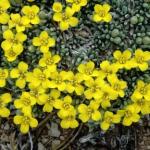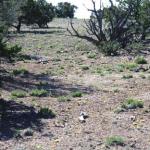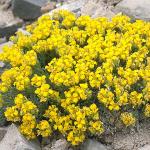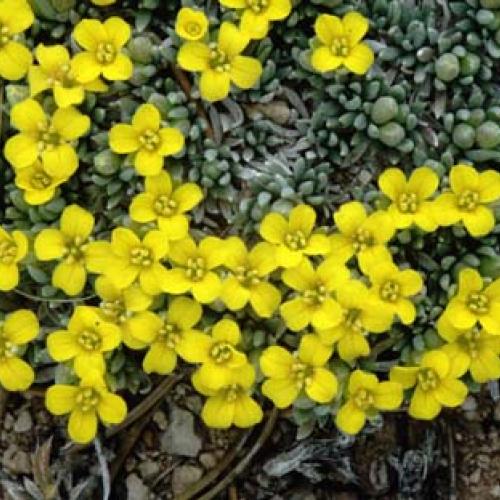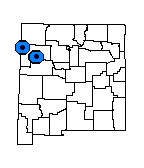Description
Perennial herb forming low, cushion-shaped clumps from an intricately branching, subterranean caudex; herbage silvery-gray, covered with a crust of flattened, stellate hairs; hairs usually with 5 main rays, each twice bifurcate into 20 tips, rays somewhat fused near the center by a thin, narrow webbing; stems crowded, buried among and not exceeding the leaves; leaves linear-oblanceolate, 3-8(13) mm long, 0.7-1.4 mm wide; flowers and fruits in dense, few-flowered racemes, not or barely exceeding the leaves; pedicels straight to slightly sigmoid; sepals 4, yellow-green, 3.7-4.8 mm long; petals 4, deep yellow, spatulate, 5.2-6.5 mm long; fruits slightly inflated silicles, ovate, glabrous, reddish at maturity; styles 1.8-3 mm long in fruit; seeds suborbicular-ovoid, 1.5-2.4 mm long, 1.3-1.9 mm wide, strongly mucilaginous when wetted. Flowers in May.
Similar Species
The sympatric Physaria fendleri has longer stems and leaves, larger flowers that have a deep orange eye (veins of the petals near the eye are also orange), and its trichome rays are fused with a thin webbing for at least their length (seen with a hand lens). Physaria arizonica is allopatric to the west and has strongly pubescent rather than glabrous fruits. The rare P. tumulosa of south-central Utah is very similar to P. navajoensis. Physaria navajoensis has mucilaginous seeds and its flowers have a pale orange eye where the petal blades narrow to their bases. Physaria tumulosa seeds are not mucilaginous and its petals are uniformly yellow.
Distribution
New Mexico, south-central and northwestern McKinley County; adjacent Arizona, Apache County; Utah, Kane County.
Habitat
Mesa rims of Todilto limestone in sparse piñon-juniper woodland; 2,200-2,320 m (7,200-7,600 ft).
Conservation Considerations
Mining is a serious current and foreseeable threat to this species. Outcrops of Todilto limestone are not abundant in this region and are actively mined for road base material and also frequently trucked to the portland cement plant at Tijeras, New Mexico. Habitat at one of the populations has been extensively quarried and the Physaria navajoensis there exist on only a narrow remnant of the mesa rim. This species has not been found on the Todilto limestone outcrops east of Thoreau, some of which have been completely mined out.
Important Literature
*O'Kane, S.L., Jr. 1999. Lesquerella navajoensis (Brassicaceae), a new species of the L. hitchcockii complex from New Mexico. Madroño 46(2):88-91.
Al-Shehbaz, I.A. and S.L. O'Kane, Jr. 2002. Lesquerella is united with Physaria (Brassicaceae). Novon: A Journal for Botanical Nomenclature from the Missouri Botanical Garden 12:319-329.

